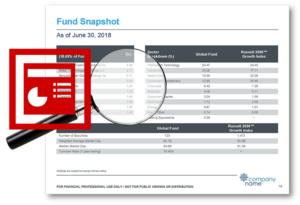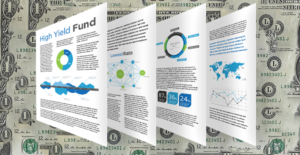[Podcast] Solving the Content Automation Problem and Achieving ROI

Listen to our guest, Terry McDougall, provide expert advice on how to carefully evaluate content automation vendors, total enterprise costs, and ROI potential.
Terry McDougall, Founder and President of Bright Beam Consulting, sat down with Synthesis CEO, John Toepfer, to discuss best practices with regard to evaluating automation vendors and calculating TCO and ROI.
Bright Beam Consulting is a marketing strategy and coaching consultancy focusing on small and medium-sized businesses and specializing in the B2B space. Terry has had a long career in financial services marketing, including working with two major financial services organizations. Most recently, she was the US head of marketing for a major global asset manager selling investment products in North America, EMEA and APAC. With her 20+ years working in financial services, she brings valuable expertise to the conversation around evaluating vendors and making sound technology buying decisions. We hope you’ll take away some useful insights from this episode.
Thanks for listening, and enjoy!
The following is a transcription of this podcast:
Emilie:
Joining me today is John Toepfer, founder and CEO of Synthesis Technology, and our special guest Terry McDougal. Terry is the founder and president of Bright Beam consulting and formerly the US head of marketing for a major global asset manager selling investment products in North America, EMEA and APAC. Her firm is a marketing strategy and coaching consultancy focusing on small and medium-sized businesses and specializing in the B2B space. Terry has had a long career in financial services marketing, including working with two major financial services organizations. So, thank you for joining us.
Terry:
I am so glad to be here.
Emilie:
I am so glad you’re here. So, Terry and I, we’ve gotten together for coffee a couple of times to talk shop. Recently, after talking about our kids and our favorite concerts, we got to talking about ROI, and how asset management firms should be looking at calculating ROI in their technology implementations…specifically when automating marketing materials like fact sheets and pitch books. One of the things we kept coming back to was how the implementation is key to nailing your business case and reaching your ROI goals.
John:
Well, even beyond that, ROIs, I have a love-hate relationship with the whole topic of ROI. I love it because I love spreadsheets that really lay out what’s going on and bring things down to numbers that quantifies the real costs of things. I hate it because I run into very few people in the industry who really care about the ROI on their initiative, and I think most of the time most ROI white papers and calculators are ignored when they hit the client’s desk, and people go with a gut-based opinion instead of a mathematically-driven decision on where to spend their time and energy and what types of products to buy. Terry, in your experience, do you see analytical or gut decision making being more present in the executive decision suites at asset management firms?
Terry:
Well, certainly I think that we believe that we’re being analytical, but in my experience we haven’t really examined the entire process and been able to determine the cost of what the current process is, and I think that if the decision makers in procurement and the leadership within asset management understood that, it would be very clear that it’s important to go ahead and put a marketing automation system in place and to do it quickly.
John:
We work with an east coast asset manager who many, many years ago went to market looking for a document production system, they actually did a full Six Sigma analysis of the cost of operations. They brought in consultants who did time motion cost risk analysis, how many people had to touch this discussion or be part of the problem, how many meetings took place, how many times did discussions about these documents interrupt other meetings, so they figured out the full, real cost of producing the documents, and the dollar value they came up for the potential savings for applying automation of the process was enormous, which was great. That fed into what we were working on marketing to the client at the time, but in almost 20 years of selling this type of technology, that’s the only case study I have where a firm has taken it that seriously to figure out what all those hidden costs are.
Terry:
Yeah. I think typically they don’t want to take the time away from other things to examine that.
John:
It’s a hidden cost in itself.
Terry:
It really is, but it’s surprising because I think that it would be valued a lot more if they understood the true cost, and what I found when one of my former employers was going through this was that marketing was actually in control of the process of developing all of the fact sheets or producing the fact sheets every quarter, and when they decided to look for a vendor, they took the project out of marketing’s hands, and I tried to provide input and insight into what the process was, but it wasn’t fully considered. The reality is, I’m not sure that I even knew the full extent of how many people touched it, how many man hours went into it. I do know, or at least surmise that I don’t think that the calculations that they used in the business case were actually high enough, and so that has an impact on the decision that they made.
John:
We’ve built a couple of ROI calculators, and the most recent one applies a rules-of-thumb model, so very simple. Here’s a rule of thumb of what your overhead costs are per document that you’re supporting, and the numbers come out reading pretty high, but what we did is we took this calculator and we put it in the hands of people like yourselves who are experienced leaders in the industry, and they uniformly had the same reaction. Their first reaction was, “Oh, that’s big,” but then they sat down and thought about it and starting building some spreadsheets and realized no, that’s the correct number of what it really costs to run these operations.
Terry:
Yeah, yeah. I think that there’s maybe a little bit of fear involved in really knowing that number as well, and I think some people don’t really want to divulge that for fear that somebody might take it and say, “Well, if we get a marketing automation system in place, we can just get rid of half of marketing.”
John:
We totally had that from a west coast asset manager we work with today. They had a really smart, really visionary leader who said, “We need to spend this money. This is the right way to run our business,” and we got all the way through the purchasing and procurement process and we got the contract put in front of the CFO to sign, and the CFO looks to the project sponsor and says, “So, how many will I get to fire?” No, that’s not the goal. That’s not the ROI. It’s not by firing people. It’s by making really much better use of the people that you have.
Terry:
Yes, yes. Well, one of the things I found really interesting was at a former employer there was a desire for marketing to be able to do more strategic projects and have more vision, but we were very lean, and you gotta keep the lights on, so we’re doing the things that we’re required to do every quarter, and it’s difficult to find the time to do those strategic projects and to be more visionary if you’re saddled with the things that are required from a regulatory and compliance standpoint, and I think sometimes it’s hard for people to even envision what would be possible if you could get some of those required burdens off of your plate.
John:
What do you say when an internal group, like an IT shop, comes and says, “Oh, you’re whining that such and such takes too long. We can build you a system to automate that”? Is your reaction positive or negative when the internal IT group shows up and makes that type of offer?
Terry:
Well, I think that there are people in the marketplace who understand this industry better than the IT folks who are just very focused on IT and don’t really understand the greater environment, and then my experience has been also that custom-built things become a burden over time, whereas if you’re dealing with the vendor who’s constantly updating, it’s outsourced and it’s just easier.
John:
Well, and the incentives are in line with the commercial version of the software. The commercial version has to be solid. It has to be up-to-date with features.
Terry:
Right. Absolutely.
John:
It has to be maintained, where the internal system, the delivery, as soon as it’s delivered it’s a cost center that they want to spend as little money as possible to enable, so basically all the advantages and incentives tend to favor the commercial vendor, but what we see in the market right now is a fairly huge push to do-it-yourself solutions and internal build efforts. We’re kind of waiting that out. We think it’s gonna run its cycle, but it’s mystifying to me how they’re able to justify the internal spend versus buying quality commercial software.
Terry:
Well, they’re not taking the full cost into consideration, and I think that that’s why a lot of these decisions are being made. They’re very short-term-focused and not really looking at the full life cycle and the cost over the course of that life cycle.
John:
Aside from the internal IT department volunteering to do work that they may not fully understand, the other trend we see very common is almost every procurement decision these days goes through the procurement department whose motivation seems to be to break the problem down into a commoditized definition and then get the best bid for it. That to me has very similar problem in that it emphasizes simplifying the problem versus truly understanding the problem. Do you see that, and how do you address that as an insider at those companies?
Terry:
I’ve absolutely seen that, and it is a frustration for those of us inside organizations as well because a lot of times the solutions are very different, and it’s hard especially when it’s something specialized like asset management. There are a lot of vendors out there that are innovating, and the differences might be pretty distinct between the various vendors. It’s hard to break those down into commodities and then base the decision solely on price, and again, I think that there are a lot hidden costs that are not taken into consideration in the business case when they’re looking at different vendor solutions.
John:
We’ve seen some clients take a direction of embedding either a business analyst or an IT representative in the business group, in the department, and with the idea being that the decision can be made with more sensitivity to what’s really going on in that department. I think that’s a fairly positive trend most the time. Have you seen that?
Terry:
I haven’t seen that. At my former employer, procurement was a centralized function, and I spent a good deal of time educating them about vendors that I wanted to use or the business problems that we were looking to solve.
John:
So, were you able to pre-vet the vendors and give purchasing a list of the vendors that you wanted to speak to, or did somebody outside come up with the vendors and drop them off for you to look at?
Terry:
No, I had some influence on the vendors, and typically I would put forth vendors that I thought could solve the problem that we were facing, but there are so many people that are involved in the decision that it’s difficult sometimes. A lot of times the people that have the clout don’t fully understand what vendor is going to provide the best solution. For example, leaders within asset management could have an impact or have influence with procurement, but a lot of times they don’t understand the details of the solution that the vendor is going to offer, and so if it’s hinging on something small or pivotal and they don’t understand that, they’re not gonna be able to make that case.
John:
Right. Yeah. I’ll give you a trick of the trade from the inside of the vendor community that’s not gonna be a secret to anybody, which is as you’re going through the sales process and you’re responding to RFIs and RFPs you answer yes to every single question asked, and the question I have for you then, if every vendor is following that rule, how do you as the purchasing party decipher which vendor actually knows what they’re talking about and which one’s just saying yes because they feel like they have to?
Terry:
Well, I think that what’s most important is for me to understand the benefits that matter to me, and to really question the vendors in depth about [00:14:30] those areas. I mean, some areas are gonna be sort of commoditized and it doesn’t really matter. They’re all pretty much in line, but there are going to be some areas that matter very much to me, and I know where the potential headaches might lie, and so I’m gonna ask a lot of questions around that and hope that the vendors through demos or whatever can demonstrate their expertise in that area.
John:
I think that’s the right approach. I mean, all RFP responses are extremely long because we write very long answers to try and illustrate that when we say yes we mean yes. It’s yes, and this, and this, and this, and there’s four different options for that, so they understand that it’s not just a generic yes from a vendor who just says yes all the time. Then when we come to the costs side of the equation, we work hard to give case studies of examples of similar related work and how the cost structures and whether the projects met their goals and internal resource requirements, so we try and provide all that evidence. The risk is that client isn’t listening because our message is backing a possible more expensive on the surface solution, and they’re believing a vendor who’s saying, “Oh, this is easy. They can do this cheap.”
Terry:
Right. And I think that I was just thinking the question is what does yes mean, because yes, they can do it, but is whatever the outcome going to be satisfactory? Emilie and I were talking about this, a situation that we had with template conversion where unfortunately in this situation I had some input into the requirements with the vendor, but probably not as much as I should’ve had given the fact that my team was the one that was managing the fact sheet project. Someone else was leading the project. They asked me a few questions. I provided the answer. They made a selection of a vendor that said that they could seamlessly convert our InDesign templates to PowerPoint. They did convert them, but the project manager came back to me and said, “These look terrible. What happened,” and as I was saying to Emilie, it’s like taking a program that’s a Ferrari and then kind of making it into a Yugo.
John:
Right.
Terry:
Right? I mean, it’s a very powerful design program, and then taking the most basic presentation software and PowerPoint, it absolutely does not convert.
John:
So, taking an InDesign file that’s beautiful and branded and turning it into PowerPoint, you’re gonna lose something in the process. One vendor’s gonna say, “Well, a conversion’s gonna require blah, blah, blah.” Another vendor’s gonna say, “Oh, yeah. It’s seamless,” and-
Terry:
It converted. It didn’t look good, and if I had been more involved, if I had been asked to be more involved, I could’ve translated that this is a Ferrari, you’re converting this a Yugo and that’s what it’s going to look like.
John:
Now, from a return on investment perspective, what was the impact of that lack of fidelity in the conversion process?
Terry:
Well, what I recommended was that we actually take the PowerPoints and send them back to the designer and have her start from scratch. The price tag for that was in the tens of thousands of dollars. I actually thought it was pretty reasonable per template conversion. That was actually rejected, I think, because they thought that the price tag was a lot, but I also think that the launch date was missed because of the problems with the conversion, and I actually think that that investment at that time would’ve saved in the long run, but that was another quarter, and that wasn’t part of the original business case, so it’s kind of interesting to think about what the actual return on the investment was or whether spending a little bit more on the front end might not have been better if they’d made the date.
John:
So, the procurement story or the onboarding story you’re telling has to do with the decision of this firm to buy a solution that had a large do-it-yourself component to how the work got done and deployed, correct?
Terry:
Yes, although I do not believe that the people that made the decision understood that there was gonna be a do-it-yourself because they were told by the vendor that it could be a seamless conversion of the templates from the InDesign files.
John:
Was that true also for all the date elements of doing this type of project? Did they think the vendor was doing that?
Terry:
No, I think that there was an understanding that there was gonna be a lot of work that was required to map the data, and I actually didn’t have a good view into what was going on there.
John:
Yeah. Another hidden cost component that’s interesting, when we’re pitching a solution, if we go too far in describing how much care it takes to get the data right, it tends to put people off from the project, but it’s critical. There is a ton of work to do to get data wrestled into the right shape for a public-facing display document, and if you ignore that you’re at your own peril for the success of the project and the cost of the project.
Terry:
And the risk as well, because these fund fact sheets, they need to go through regulatory review or compliance review, and there’s potential fines and risks involved with not having the data be right, and so it’s critical that the proper processes be put in place, and frankly it saves a lot of time and I think once they’re put in place it actually is less prone to error than the processes that involve more human involvement. Just it’s a lot of work on the front end, though. It is a little bit of a bummer or depressing to think about how much work goes into this, and usually these processes have been built over years. You start out with a few funds and you set it up, and then you just kind of … It just grows from there, and then when you go back and reexamine it, it’s huge. You’ve got a lot of data coming in from a lot of different places. The process that we had at my former employer, it was in place when I came in, so to transition it I was gonna have to really dig into a lot of layers that had been put in place by several different predecessors. So, it is overwhelming, but I think that one of the things that’s very helpful is if you can get a partner who’s been through this and knows how to guide you through every step, I think it’s critical, and having someone who sees the big picture, who’s been through the wars, knows where the pitfalls lie and can guide you is really, really critical.
John:
As you say that, are you picturing a vendor resource or a consultant or BA that you use on the inside, on the client side?
Terry:
Well, ideally, if you’re hiring a vendor who can kind of guide you, I think that that works very well. I mean, if they know what they’re product can do and they’ve guided other clients through the process, and in many cases larger and more complex relationships than probably what we had at my former employer, that actually gives me a lot of confidence to know that if you’ve worked with some of the major asset managers and then you’re coming in, I’m confident that you could help us when we have a couple dozen or a few dozen funds.
John:
One of the asset managers that we work with who’s a Midwestern-based company, they’re fairly old-school and they have kind of the built-up legacy of, well, we do it this way because of this reason type of thing, but the manager, the person who’s leading the operations we’re involved with on the inside, he’s a little bit of a maverick, and he loves to get people in a room and say things like, “What are we missing? What are the best practices? What really should we be trying to do?” When people say things, he very often has a tendency to say, “Well, let’s have that discussion without the vendor here.” They want to think internally and then present something to the vendor versus availing themselves to the resource of the vendor who sees 25, 50, 100 different clients and can say, “This seems to work well, and this doesn’t work well.” Even if the vendor doesn’t have the magic answer, at least them being there as decisions are being discussed and debated makes them an insider and more able to serve the client versus something being handed off it with a cold start. Here’s our decision, go.
Terry:
Yeah. Well, I think that there can be missed opportunities when you don’t partner fully with your vendor because there are things that you don’t know that you don’t know, and then also the same with the vendor. They understand what they can provide, and they may make assumptions about how you’re doing things, and I guess if you don’t have full disclosure, certainly things can fall between the cracks. My approach towards vendors has always been I’ll take vendor meetings any day of the week because the vendors, that’s their specialty. They’re focusing on that every day, and so they’re gonna stay on the cutting edge of what’s going on. They’re meeting with other companies in my space, and so they kind of know what the best practices are, and I look at it as a really great opportunity to gain intelligence on what the best practices are. So, we were in the business, of asset management, not in the business of marketing automation for asset management, and that’s just a means to and end where for you guys — that’s your whole business.
John:
Yeah, exactly, and something we emphasize at a part of our sales cycle is we’re not a financial printer. We’re not a fulfillment shop. We’re not a trading firm. We’re not a website content manager. We are a publishing firm and we do nothing but take care of this type of business problem, and all the mysterious and crazy ways that it happens at clients. One of the things that is always a complicating factor and is easily ignored by an outsider showing up with a simplistic view of things is just how complicated the typical asset management company is today, just based on the legacy of evolution of their product lines, firms they’ve purchased, new strategies they have deployed, new systems that have come into place.
There’s a little bit of a feel from strict asset management, but we do a lot of work for a large insurance company and a lot of data aggregation work, and the trick is there they have five legacy systems for record keeping, and we have to channel all that data into one warehouse so that we can publish the documents that are required. That data aggregation project was just enormous, and nobody at the firm could describe to us how big a problem it was gonna be. We had to discover that from the inside of the process and then collaborate for months and months to get it right, but yeah, the legacy of how the business got built and then needs to be supported, no one gets a clean slate. You don’t get to tell your client to start over and do everything, and they’re using the same strategies and techniques, so that means the vendor and the client have got to be able to collaborate and speak honestly with each other about the compromises and the decisions that need to be made.
Terry:
I think being willing also to partner in discovery, like I was saying, the whole process of the fund fact sheets at my former employer, that had been put in place by predecessors, and it was working when I came in, so I never dug into it. I didn’t really need to.
John:
Yeah, it is what it is.
Terry:
I knew that it was coming out, and once we were looking at automating it, that’s when I started examining it a little more closely and realized it was very complex, but I think when you’re transitioning something like that, you just have to take it step-by-step and have good plan, but also be prepared for contingencies, and kind of going back to what I was saying earlier, it’s very helpful to deal with somebody who has been through it and kind of knows where to look for where the issues might typically lie so you’re not shocked that somebody can say, “Hey, I know this is common for people to do things this way, and so maybe we should take a look and see if this exists within your current process because we know how to deal with that.”
John:
Yeah. Have you ever funded a vendor in what we call a phase zero project where the vendor is a paid consultant on staff to help refine the deliverables, requirements and descriptions before a decision has been made to license the software or really engage in the implementation project?
Terry:
No, I never have been involved in something like that, and I think that that might be a little complex given the procurement requirements.
John:
Right. Yeah. We’ve offered that a number of times. I think we’ve only been taken up on it once, because of course people are also afraid the vendor’s gonna just steer the discussion in their favor at that stage, but at the same time, we see there’s probably five different prospects in our queue right now who are just stalled at their internal discovery phase, and again, that goes into the ROI bucket of how much money are they gonna spend to discover what their business problem is, much less execute on it.
Terry:
How many more quarters are you gonna go through using this inefficient process? You know?
John:
Yeah. There’s an east coast company that we’ve been participating in their RFP now for I think it’s about 16 months, and we sent them a proposal for a quick start program just trying to help them get off the dime, but they have enormous needs and it’s costing them not to move forward on them. But, finding the time to focus and just make it happen seems just too elusive to so many companies because we’re all so busy. When’s the last time you met anybody in this business who wasn’t just underwater with how much was on their plate?
Terry:
It’s really, really hard, and when I was mentioning the transition at the former employer, there was a business that was sold and some personnel was kept on from that and they actually were moved over to work on this transition process. Otherwise, honestly, there wouldn’t have been the headcount to do it. If it had been given to me and I had to do my day job and then focus on a very complex transition to a new system, it really would be almost impossible to do, and I think it would be hard to be able to concentrate on all of the details and have the focus to think through the process and think about how does it transition to a new system. It would be very difficult.
John:
So, back on the concepts of ROI, one of the things that we’re focused on in trying to educate clients about the potential ROI of a solid automation program is measuring the risk to their business of not having a solid process in place. However, putting numbers around risk is very difficult to do, especially an outsider. Have you attempted to do that, or do you have advice on how somebody could approach putting a number on the risk of not having automated processes or automated processes that they’re proud of?
Terry:
You know, I think that’s a difficult one, and I think that it’s sort of the downside. What I would kind of analogize that to is back before the financial meltdown, people weren’t really thinking that the housing market could go down and they weren’t looking at worse case scenarios, and in a highly regulated industry like asset management, what happens if you can’t get the fund fact sheets out on time? What happens if you send out the wrong information to a client and they invest based on something that didn’t get properly vetted by compliance? What might the fines look like in a case like that? I don’t think that most firms really look at that, and that becomes an increasingly possible risk. The more complex that these systems get and as the teams get leaner and more is expected, it very easily could happen that something gets missed and you run into a situation where there’s a fine associated with it.
John:
The other thing that we see as a huge business risk, the old hit by the bus metaphor.
Terry:
Absolutely. Oh, my gosh. Yeah. We were talking about the legacy processes and who knows how it even began and whether what we’re doing is even efficient. A lot of times there is some legacy employee that they’re the only one who knows where all the bodies are buried, and maybe they get so stressed out that they have to go in the hospital, and then you don’t even know what to do to actually make the process work.
John:
We got involved with a TAMP-style asset manager a few years ago, and TAMPs can be very complicated financial assets, five layers deep of assets holding assets holding assets is common, and when he got involved with them, there was one guy with the most enormously complicated spreadsheet you ever saw in your life running the show in terms of data reporting for the funds, and it worked. It kind of worked fine in some ways, but if that guy got hit by a bus, got disgruntled, or the spreadsheet got corrupted, this is not a sustainable business practice. You need a proper data warehouse, which is what we provided to them.
Terry:
Right. I think that it’s critical, and at some point you’ve gotta bite the bullet and just do it, even if it’s complex, and I think again, going back to the process that was in place at my former employer, I think that if I had really dug into it, I would’ve found a lot of inefficiencies in the process itself, and I think that doing a transition to an automation system gives you the opportunity to put clean process in place. It takes time. It takes a lot of thought and planning, but once it’s in place it’s clean. It flows well and can be documented.
John:
How do you put an ROI number on that, though, especially when it’s partially talking about risk? I mean, Emilie’s always working hard to produce great content for us describing the benefits of a automated solution and our automated solutions, and she’ll say, “I want to put a number out there. What number can I use to describe what they can save through decrease in firm-wide risk?” I don’t have any idea how to flop out of a number on that.
Terry:
Yeah. I don’t know, but I just think that the longer you allow an unwieldy process to continue, and then also if there are additional regulatory requirements that get layered on top of an already complex process, the more likely you are to have a breakdown or a disaster, and I think that if, kind of going back to what I said in the beginning, if you look at the entire process and you really put costs to it, that’s where you’re gonna understand what it’s truly costing you to do that. Now, you have to get over that hurdle of the initial investment of the system and also the investment and the time for the implementation, but once you get that done, and then it’s gonna be more efficient. You’ll be able to redeploy resources to other projects, and it’s going to be less risky.
John:
Yeah. I think this has been a really good conversation. I think we’ve got some really good insights on the ROI, the risk, and the procurement process for automation technologies.
Terry:
I’m not sure how to crack the nut of being able to influence in these very large organizations, but I do know that it’s like Jenga, right? It gets higher and higher, and at some point if you don’t stabilize it, it’s all gonna fall down.
John:
Right. Absolutely true. I’ll conclude with this story, I guess. There’s a concept in technology firms like us which is called technical debt or tech debt, which is that you have to live tomorrow with decisions you make today, and as those become more and more out of fashion for your future, they are now a form of debt that the organization at some point has to pay down. I think there’s an analogy for that within the marketing organizations at major financial services firms in that there is a marketing debt or a process debt. Maybe it is tech debt that every once in a while you need to really take it on and deal with it, otherwise it can overwhelm your entire organization.
Terry:
Yeah, I agree. At some point, you’ve gotta pay the piper.
Did you enjoy this Podcast?
Subscribe on iTunes or Google Play to get all the episodes for free!
 From the Blog: 7 Problems With Automating Factsheets In PowerPoint |  From the Blog: 3 Factors that Complicate Factsheet Automation |  From the Blog: How much does it cost to automate factsheets? 🧐 |




 Compare the Top 3 Finserv Content Automation Vendors [White paper]
Compare the Top 3 Finserv Content Automation Vendors [White paper] Create Pitchbooks the Drive Sales [White paper]
Create Pitchbooks the Drive Sales [White paper] Build vs. Buy: Should Your Financial Services Firm Outsource or Insource Marketing Technology? [White paper]
Build vs. Buy: Should Your Financial Services Firm Outsource or Insource Marketing Technology? [White paper]  10 Tips for Rebranding your Fund Marketing Documents [White paper]
10 Tips for Rebranding your Fund Marketing Documents [White paper]



